| 1971
SA Republic Anniversary & 1972 SPCA |
FDC SWA No 3
The first correctly numbered envelope
20,000 Envelopes produced
In terms of the numbers of envelopes produced for
SWA first day covers
they are relatively low. The reason being that when
Pretoria initially took over the distrubtion of SWA
New Issues, the number of account holders was still
low
|
|
| |
31
May 1971
Tenth Anniverary
of RSA |
|
|
| |
19
September 1972
Centenary of the SPCA
FDC SWA No 4
18,000 envelopes produced |
|
The SPCA was the
last issue that replicated a RSA design |
|
|
| 1973
Adolph Jentsch Paintings |
|
1
May 1973
Paintings by
Adolph Jentsch
Five values |
.jpg) Red Sand Dunes
Red Sand Dunes |
.jpg) After the Rain
After the Rain |
.jpg) Barren Country
Barren Country |
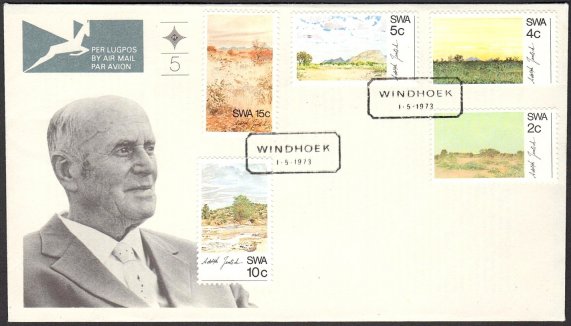 FDC SWA No 5 - 28,600 Envelopes produced
FDC SWA No 5 - 28,600 Envelopes produced |
.jpg) Schaap River
Schaap River |
2c
Cylinder 351 - 354
4c Cylinder 355 - 358
5c Cylinder 343 - 346
10c Cylinder 347 - 350
15c Cylinder 339 - 342
|
.jpg) Namib Desert
Namib Desert |
Adolph Jentsch
was born in Germany on 29 December 1888
Lived and Educated in Dresden - He settled in
SWA before WWII
His Landscape Art captured the mood of his enviroment
He passed away at Windhoek on 18 April 1977
|
|
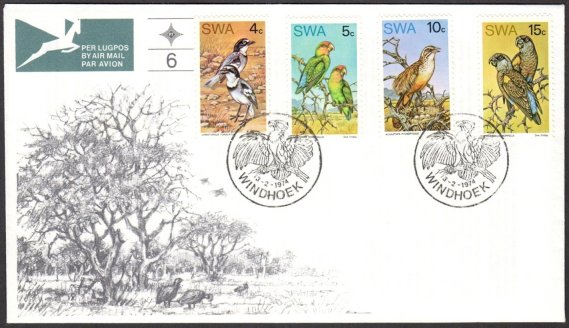 FDC SWA No 6 - 35,800 Envelopes
produced
FDC SWA No 6 - 35,800 Envelopes
produced
|
|
4c White-tailed
Shrike on a commercial
cover to South Africa
Cancelled GOBABIS 5 IV 1974
|
|
| 1974
Twyfelfontein Rock Engravings |
|
|
10
April 1974
4c Cylinder
P32 31 21 - 18
5c Cylinder P30 22 - 25
15c Cylinder P26 - 29
|
|
|
Designs
4c Giraffe and Antelope
5c Elephant and Hyena
15c Kudu Cow |
|
|
|
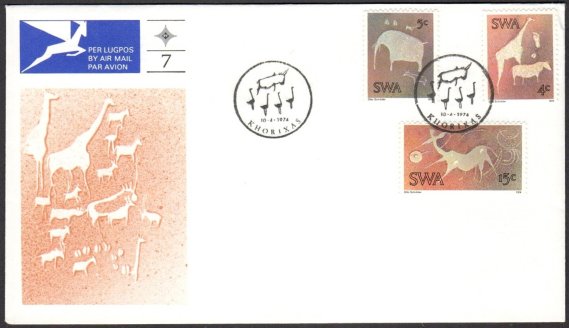 FDC SWA No 7 - 36,821 Envelopes serviced
FDC SWA No 7 - 36,821 Envelopes serviced |
| Twyfelfontein or Ai-Ais
(Spring or well) lies to the North-west of Brandberg and 60
kms from Khorixas (previously Welwitschia)
The site boasts around 2,000 rock engravings, unfortunately
many of these engravings are badly weathered |
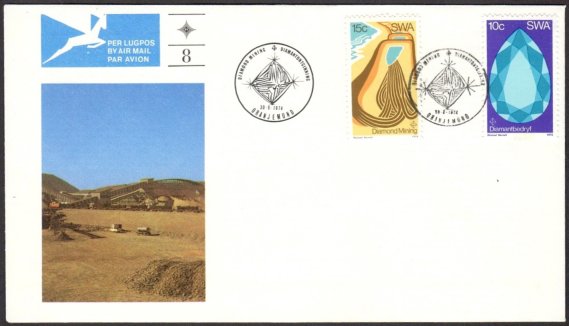 FDC SWA No 8 - 38,196 Envelopes serviced
(42,000 printed)
FDC SWA No 8 - 38,196 Envelopes serviced
(42,000 printed) |
|
|
30
September 1974
10c Cut Diamond
Cylinder P39 - P36
15c Diamond Mining
Cylinder P35 - P32
|
|
FDC SWA No 8 -
38,196 Envelopes produced
The world's richest deposits of diamonds is found
north of the
Orange River between the Atlantic Ocean and the
desert
|
|
|
On 14 April 1908 a railway
worker, Zacharias Lewala, who was working on the railway line
between Luderitz and Aus found a 'shiny-stone'
and
showed it to his supervisor, a railway inspector August Stauch,
who recognized it as a diamond
Stauch obtained a prospector’s license and as soon as
it was confirmed that the stone was indeed a diamond, the
rush to Kolmanskop was on
In 1983 SWA issued a set of four stamps to commemorate the
75th Anniversary of the Discovery of Diamonds and the 40c
value depicts August Stauch
Sadly Zacharias Lewala did not receive any recognition other
than a vague mention on the FDC inset as a Coloured Railwayman
|
| 1974
Centenary of the Thirstland (Dorsland) Trek |
|
|
13
November 1974
Cylinder
P44 - 40
FDC SWA No 9
38,080 Envelopes serviced
(40,000 printed)
|
|
This issue commemorates
a series of Treks from the Transvaal through the waterless
Kalahari between 1874 and 1905. The last group left
the Transvaal after the end of the Boer War in an
attempt to escape the misery and poverty that was
a result of that conflict.
In 1884 a number of trekkers wished to return to South
Africa, but when reaching Grootfontein settled there.
Four years later they returned to Angola.
|
|
|
|
The first group of the Dorsland Trek set out
on 27 May 1874 under the leadership of Gert Alberts. Different
groups followed the first Trek, setting off from areas around
Rustenburg, Groot Marico and Pretoria. Their primary destination
was the Humpata highlands in Western Angola. These groups
had to traverse the arid Kalahari desert either via Bechuanaland
or SWA. It was the harsh and dry conditions that they experienced
in the Kalahari that gave the trek the name Dorsland Trek
(In Afrikaans) translated Thirstland Trek. |
|
|
|
By 1905
the Boer community in Angola numbered some 2,000 but
their chosen isolation brought friction with the Portuguese
who pressed Catholicism on these brimstone Calvinists
and insisted that their children attend government
schools. All this led to fears that their Afrikaner
heritage would be lost.
After 1928 nearly the entire community left Humpata
with their wagons, Bibles, furniture and guns. With
help from the South African Government they settled
in the Outjo district of South West Africa. |
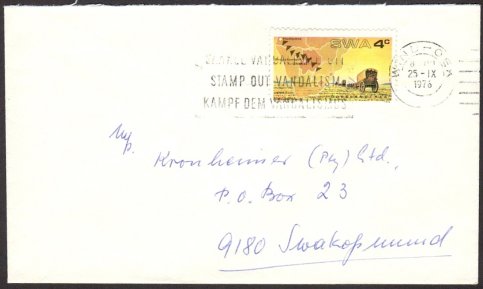 A Commercial envelope with the 4c Dorsland
Trek
A Commercial envelope with the 4c Dorsland
Trek
Cancelled WINDHOEK 25 IX 1976 |
|
| 1975
Protected Birds of Prey |
 FDC SWA No 10 - 46,518* Envelopes serviced
(45,000 printed)
*Data conflicts between SACC and GPO Bulletin
FDC SWA No 10 - 46,518* Envelopes serviced
(45,000 printed)
*Data conflicts between SACC and GPO Bulletin |
|
4c
Peregrine Falcon
-
Because of pesticide in its food chain, numbers have
fallen drastically. it preys on birds the size of
pigeons. In SWA it nests on cliffs. |
|
5c
Black Eagle - Found in mountainous
country and preys almost exclusively on rock-rabbits.
Lays two eggs in a huge cliff nest, but only one chick
will fledge. |
|
10c
Martial Eagle -
Has a wing-span over two metres and its main prey
is hares, meerkats, leguans and game birds. Many are
killed by farmers as it occassionally targets sheep
or goats. |
|
15c
Egyptian Vulture - Vitually extinct
in Southern Africa and occassional migrants seen from
the North. Supplements its carrion diet by breaking
Ostrich eggs with the aid of stones. |
|
.jpg) Kolmannskop
Kolmannskop |
23
July 1975
Three
values
5c Cylinder
P67 - 71
9c
Cylinder
P71 - 75
15c
Cylinder
P71 76 - 79 |
.jpg) 'Martin Luther' Steam tractor
'Martin Luther' Steam tractor |
.jpg) 'Alte Feste' Windhoek
'Alte Feste' Windhoek |
|
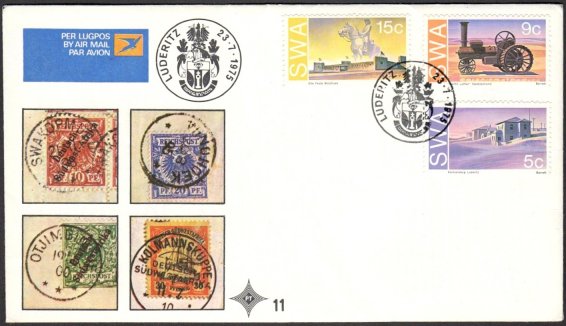 FDC SWA No 11 - 59,262* Envelopes serviced
(52,000 printed)
*Data conflicts between SACC and GPO Bulletin
FDC SWA No 11 - 59,262* Envelopes serviced
(52,000 printed)
*Data conflicts between SACC and GPO Bulletin
|
|
5c
Kolmannskop
Initially an insignificant
railway station between Seeheim and Lüderitzbucht.
Became a hive of activity after the discovery of diamonds
in 1908. The miners built a settlement that was eventually
abandoned when mining activity ceased and moved futher south.
Today this ghost town is a popular tourist attraction. |
9c
'Martin Luther' Steam tractor
Brought over in early 1896
and intended to replace
'ox-transport'. Became stuck in the desert sand and abandoned.
Was named Martin Luther due to his historic statement
Here I stand, may God help me, I cannot do otherwise.
Restored in 1973 by the Swakopmund Town Council and became
a National Monument. |
15c
'Alte Feste' (Old Fort) Windhoek Construction
of the fort commenced in October 1890 under command of Captain
Kurt von Francios. Bing a site with a strategic position plus
its hot springs it marked the founding of Windhoek. In May
1915 it became HQ for SA Forces. After WWII it was a hostel
& then a High School. Declared a National Monument in
1957 and its six month restoration began in 1962. |
|
1975 Otto Schröder
Paintings |
Otto
Schröder 1913 - 1975, born in London
and spent his early childhood there. The son of German father
and British mother, they repatriated to Germany at end of
WWI. Schröder was educated in Cologne; entered business,
but attended evening classes in art and painted during his
free time
Art Education
1932 - 1937 Landeskunstschule and part time under Oscar
Boegel and Hermann Junker in Hamburg - In 1938 studied in
Vienna
|
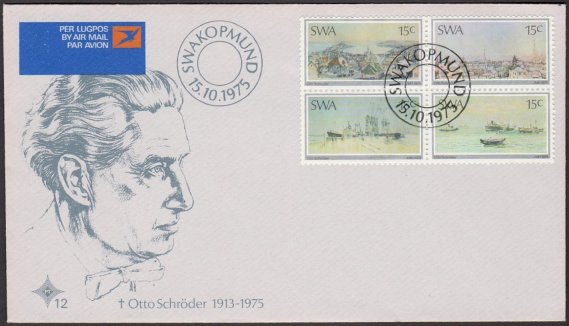 FDC
SWA No 12 - 64,571 Envelopes serviced (65,000
printed) FDC
SWA No 12 - 64,571 Envelopes serviced (65,000
printed) |
|
19
October 1975
Four
15c se-tenant values
|
|
Cylinders
P84 - 80
A and B
Also made up into SWA
first MS |
|
|
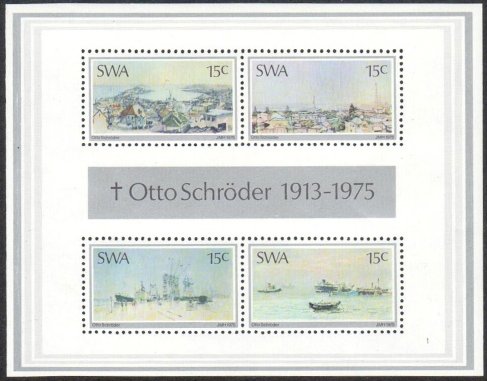 SWA MS No 1
SWA MS No 1 |
In 1939, Schröder came
to Cape Town on business, but his contract was terminated
by the outbreak of WWII and turned to art as full-time profession.
Interned with other German nationals at Baviaanspoort, Pretoria
and on release decided to remain in South Africa
In 1947 Schröder settled in Windhoek and in 1948 established
a Children's Art Centre in Windhoek. An active organizer,
member of selection committees for several national art exhibitions
and mainly interested in pastel-medium, portraits and landscapes.
He participated in numerous South African and SWA art exhibitions
and completed murals in several SWA buildings.
In 1958 Schröder wrote introductory essay for small monograph
on Adolph Jentsch. In 1962 Schröder was appointed to
new chair of Fine Arts at Stellenbosch University and a committee
member of SA Akademy. During 1967/8, a committee member of
Design Institute Pretoria-Cape Town and Fellow of Royal Society
of Arts.
His usual subject matter was the bleak, wind-swept
and melancholy desert coast of SWA, especially the towns of
Luderitz and Swakopmund.
Otto Schröder died at Stellenbosch on 13 June 1975.
|
|
31 March 1976 Pre-Historic
Rock Paintings |
|
|
 FDC SWA No 13 - 69,255 Envelopes serviced
(75,000 printed)
FDC SWA No 13 - 69,255 Envelopes serviced
(75,000 printed) |
|
The Rock Paintings
in this issue of postage stamps were copied at the following
farms 5c Stamp
- Schwarzkuppe near Maltahöhe
9c Stamp - Ameib
near Usakos. 15c Stamp
- Omandumba in the Erongo Mountains.
30c Stamp - Etemba in the Erongo Mountains
First Day Cover
- Klein Aukas near Usakos Miniature
Sheet - Alettasrust near Kamanjab
The stamps were designed by Harald Pager, the Johannesburg
author of two books on South African rock paintings.
Dr E.R. Scherz of Windhoek, doyen of rock-art research in
South West Africa, advised on the sites
|
|
THE
ROCK PAINTINGS OF SOUTH-WEST AFRICA
South-West Africa is extremely rich in rock
art, paintings being more common than engravings. These rock
paintings were executed In open rock shelters or on boulders.
Radio-carbon tests have shown that the oldest South-West African
rock paintings are 27,000 to 29,000 years old. They are therefore
the oldest works at art in Africa.
Earth colours - red in particular - were
the most popular pigments while white, black and yellow were
also used but never green or blue Chemical tests indicate
that blood or blood serum was used as a binding agent.
Human figures are the most frequently encountered
motifs and they are portrayed in a multitude of postures and
activities, the men often pictured with their bows and arrows
whereas the women are seen gathering vegetable food with digging
sticks and bags There are many beautiful paintings of game
in a variety at styles Imaginary creatures, ghosts, abstracts,
symbols and a few plants are also depicted and handprints
occur in some of the sites The most famous of all South-West
African rock paintings is the 'White Lady of the Brandberg',
which is illustrated on the FDC inset card.
The reason for the creation
of this art is still largely a matter of conjecture but it
may have had magico-religious origins connected with initiation
rites, the placating of spirits and rituals to ensure rain,
fertility and, perhaps most likely of all, success in the
hunt. |
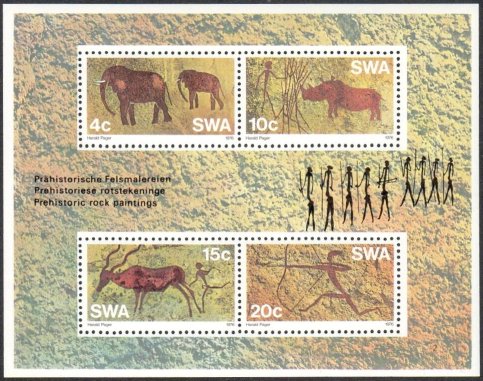 SWA MS No 2
SWA MS No 2 |
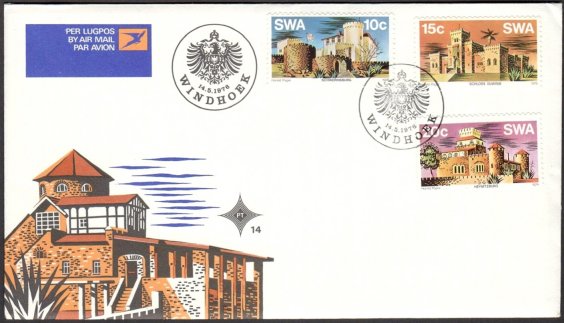 FDC SWA No 14 - 64,292 Envelopes serviced
FDC SWA No 14 - 64,292 Envelopes serviced
|
15
May 1976
Three
values
10c Cylinder
P108 - P105
15c
Cylinder
P112 - P109
20c
Cylinder
P116 - P113
|
.jpg) Schwerinsburg Windhoek
Schwerinsburg Windhoek |
.jpg) Schloss Duwisib
Schloss Duwisib |
.jpg) Heynitzburg Windhoek
Heynitzburg Windhoek |
|
|
Castles
in South West Africa The three castles featured
on the new series of stamps of South-West Africa were designed
by a German, Willi Sander, the first architect in South-West
Africa. Tradition has it that he was so taken up with his
romantic creations that in later years he built his own castle,
the Sanderberg, which is depicted on the commemorative envelope.
Two of these residential fortresses, Schwerinsburg and Heynitzburg
which were designed for German nobility, jut from the rocky
ridge above the capital city, Windhoek. The third, Schloss
Duwisib, stands on the edge of the Namib desert.
Count von Schwerin was the trend-setter of
this old-world indulgence in castle building in South-West
Africa. He built annexes and extensions to a watchtower that
guarded the small township of Windhoek until the edifice had
assumed the proportions of a castle and which was proudly
named Schwerinsburg
When Count von Schwerin married Fraulein Von Heynitz, a second
castle was built at the site of a good spring, just below
the first one. It was named Heynitzburg after Fraulein Von
Heynitz.
Schloss Duwisib was erected by the Baltic
Baron Von Wolff, an officer of the German forces and he planned
his castle to be the furthest advanced bastion of civilization.
This castle is a magnificent structure with five massive square
towers and an interior that has the nostalgic charm of a long-past
era.
|
|
The three special stamps, commemorative
envelope, stiffener card and special canceller were designed
by the Johannesburg artist Harald Pager He made a special
trip to South-West Africa to execute the assignment on the
spot.
Many obstacles had to be overcome. From a plan drawing he
had to measure the foundations in order to reconstruct the
walls, hidden behind trees and shrubs.
In the final art work he was obliged to omit much of the vegetation
so that the stamps would not look like pictures from a botanical
garden.
Imperforate Stamps
- These blocks originate from full sheets of 100 ex the Postal
Archives sold by Stephan Welz on 24 October 2001 as Lot 47 |
|
.jpg) Rock-Dassie
Rock-Dassie |
16
July 1976
Three
values
4c Cylinder
P120 - P117
10c
Cylinder
P124 - P121
15c
Cylinder
P128 - P125
|
.jpg) Dik-Dik
Dik-Dik |
.jpg) Tree Squirrel
Tree Squirrel |
|
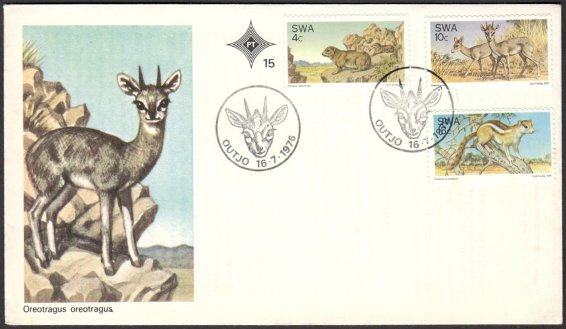 FDC SWA No 15 - 74,869 Envelopes serviced
(75,000 printed)
FDC SWA No 15 - 74,869 Envelopes serviced
(75,000 printed) |
|
4c
Dassie (Procavia Welwitschi)
These rock-dassies are only found north of the Brandberg in
Damaraland and Kaokoland. They live mainly in very rocky places
and form social colonies of up to 100 individuals. The colonies
consist of family groups with one male, various females and
their young. Although they are mainly active during the day,
they also come out on nights when the moon is full. The old
males are usually on guard. They are not very dependent on
water and are exclusively herbivorous (grass, leaves and fruit).
10c Dik-Dik (Madoqua Kirki)
The blue duiker belongs to the dik-dik-family and is the smallest
buck in South-West Africa. It has an elongated nose, which
slightly resembles a trunk, and a tuft of long hair on its
forehead. Only the ram has horns. The hind legs are longer
than the forelegs but are bent so that the animal's back slopes
to the rear. Blue duikers are found in pairs and are sometimes
accompanied by the previous year’s lamb. These buck
live in dry, dense bushveld and can do without water for long
periods.
They have common dunghills, which become quite large in course
of time. Blue duikers are mainly leaf-eaters and prefer the
leaves of Acacia trees.
15c Tree Squirrel (Funisciurus
Congicus)
The tree-squirrel is a smallish rodent with a characteristic
S-shaped tail. Tree-squirrels live singly or in pairs in trees
and only descend now and then to look for food. They are pre-eminently
day animals who sleep in hollow tree-trunks at night. Their
food mainly consists of fruit and nuts, leaves and shoots,
birds eggs, young birds, lizards and insects.
|
|
15c Augustineum
College, Windhoek
The Augustineum Training Institution hasa long
and interesting history dating from 1866, and for many years
it was the only centre where Herero, Damara and Nama teachers
could be trained. Like many other institutions of its kind
it came into existence through missionary endeavour. For almost
half a century it operated under humble though fascinating
circumstances at Okahandja and in 1968 it was moved to Windhoek
where it now caters for all the ingenous races in SWA.
The Augustineum functions under the Department of Bantu Education.
The present college with extensions was built at a cost of
R2.8 million. The buildings include a hostel for 700 students,
a high school catering for 500 pupils, a teachers training
centre for 150 students, a technical and trade centre for
150 pupils and a modern hall that can accommodate an audience
of 1,000 and also serves as a gymnasium.
The equipment in the school is modern and adequate. There
are science laboratories, a domestic science centre, a typing
room, a science lecture room and a well-appointed library.
Sporting activities are catered for on a large scale and the
necessary sports fields have been constructed on the campus.
The students are proud of their institution's history and
traditions extending over more than a hundred years. They
regard it as an accepted centre of educational and technical
training and they are facing the future with confidence, secure
in the belief that advancement both in the quality and scope
of the tuition offered can only improve in the years ahead.
|
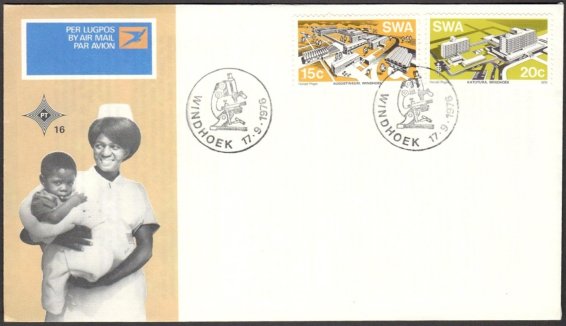 FDC SWA No 16 - 65,025 Envelopes serviced
(75,000 printed)
FDC SWA No 16 - 65,025 Envelopes serviced
(75,000 printed) |
17
September 1976
Two
values
15c
Cylinder
P102 - P101
20c
Cylinder
P194 - P103
|
15c
Augustineum College
20c Katututura Hospital
|
|
Imperforate
Stamps - Originate from full sheets
of 100 ex the Postal Archives sold by Stephan Welz
on 24 October 2001 as Lot 51 |
|
|
20c
Katutura Hospital
This is the name of the modern state hospital in Windhoek
where all Non-White population groups receive medical treatment.
The hospital, with its intensive-care unit, 11 theatres and
734 beds took four years to complete. Together with the necessary
equipment it cost over R9 million. Psychiatric patients and
consumptives are treated in an adjacent building housing 448
beds. An average of 570 in- and 260 out-patients are treated
daily by 45 medical practitioners, 365 nursing staff members
and 162 other administrative staff members. The annual operating
costs amount to approximately R4 million.
|
| 1976
Water and Electricity Supply
|
|
South-West
Africa comprises an area of 82,429 600 ha
and its topographical and climatic regions are as varied as
the appearance and customs of the peoples inhabiting them.
It is a country with an abundant mineral wealth that is as
yet largely unexploited. The mining of minerals requires a
large supply of electric power and water. Coal is one of the
few minerals that has not been found in economically viable
deposits in South-West Africa and alternative sources of power
had therefore to be considered. The greater part of the territory
has a low rainfall and consequently there are no perennial
rivers. Natural perennial sources are extremely rare. During
the previous century, the Ovambo nation settled in Central
Ovambo because of the flood-water that accumulated in the
numerous depressions.
|
19
November 1976
Two
values
15c
Cylinder
P132 - P129
20c
Cylinder
P136 - P133
|
15c
Canal System
20c Ruacana Falls Power Station
|
| Imperforate
Stamps - Originate from full sheets
of 100 ex the Postal Archives sold by Stephan Welz
on 24 October 2001 as Lot 53 |
|
The population grew and an additional water
supply has had to be provided for their support. Initially,
the Oshakati and Eta canals were built to collect the surplus
floodwater from the sparsely populated outlying areas and
convey it to the densely populated central areas. Without
this water, the area would be drought-stricken for at least
five out of every ten years.
The Kunene River in the north has an annual flow
of 5,000,000,000 cubic metres and is already being developed
and utilized as a source of water and hydro-electric power
for the benefit of the area. The water is conveyed along canals
and is pumped over long distances. The canal that will carry
water to Ovambo and later further south has progressed well.
The utilization of the water is a great challenge, but will
eventually bring relief to man, animals and plants over a
vast area.
The hydro-electric power scheme at the Ruacana
Falls needs much more extensive planning and construction.
The first hydroelectric power station will only be commissioned
several years hence. In the meantime, a great deal has already
been accomplished towards supplying this developing area with
sufficient power.
|
|
|
29
March 1977
Four
values
4c
Coastline near Pomona
Cylinder P152 - P149
|
|
10c
Sossusvlei Dunes
Cylinder P148 - P145 |
|
|
|
15c
Plain near Brandberg
Cylinder P144 - P141 |
|
20c
Dunes in Sperr Gebiet
Cylinder P140 - P137 |
|
|
The First Day Cover
for this issue includes a booklet with the adjoining
map on the front. There is a seven page write up on
the Namib in Afikaans, English and German by Herman
Steyn, the head of Philatelic Services for many years.
|
|
|
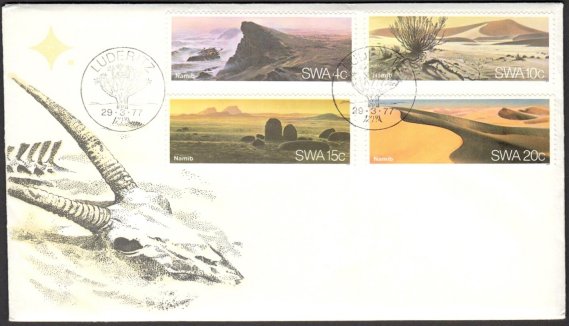 FDC SWA No 18 - 96,567 Envelopes serviced
FDC SWA No 18 - 96,567 Envelopes serviced |
|
The
size of the print in the booklet is small and is tiresome
to read.
Herman had command of all three languages and I believe
his English version is more than likely a translation
as it is heavy going, does not flow and burden’s
the brain. I OCR-ed the text which almost fills four
A4 pages.
The gist of the write
up describes the area from North to South and from
West to East. The numerous rivers, that are in the
main dry river beds, except during periods of rare
rainfall. The unrelenting climate, plants, insects
and animals which survive in this arid area. Parts
of the coast abound with birds and seal colonies
and the former is a good source for the guano industry.
The cold sea current
is rich with fish life and provides a good seasonal
harvest from the sea that includes a crayfish industry.
Part of the history of SWA is touched and an account
of the 1908 diamond rush in the region of Kolmannskop.
The foregoing includes tales of wealthy diamond
prospectors whose women bathed in champagne!
|
|
|